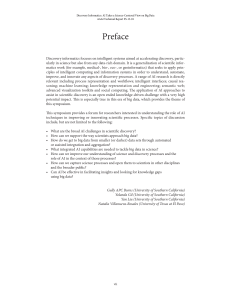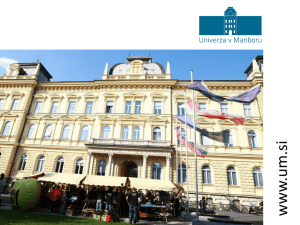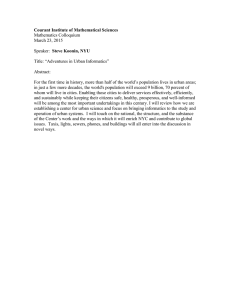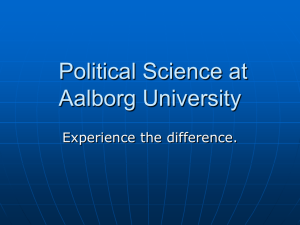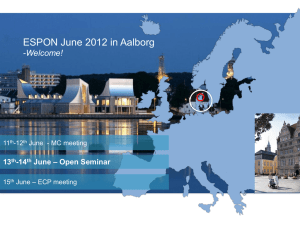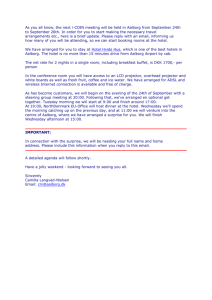pc1
advertisement
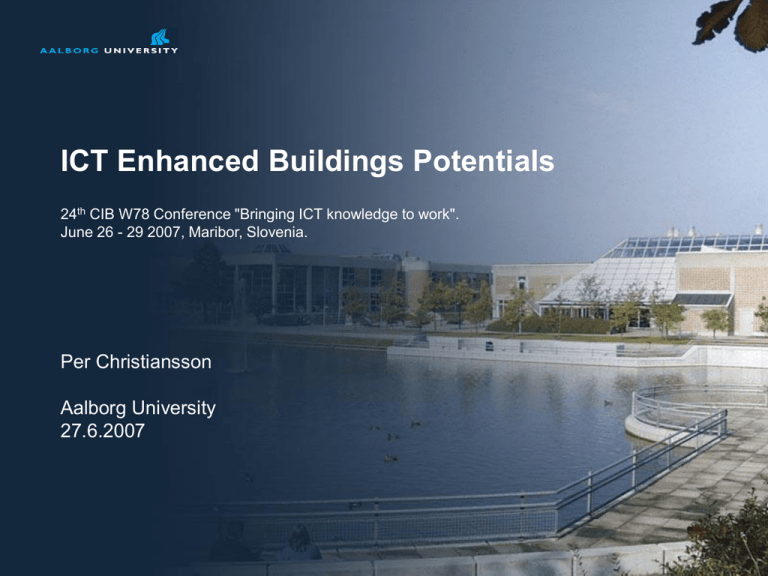
ICT Enhanced Buildings Potentials 24th CIB W78 Conference "Bringing ICT knowledge to work". June 26 - 29 2007, Maribor, Slovenia. Per Christiansson Aalborg University 27.6.2007 CONTENT • Intelligent Building history • Driving forces and trends • Intelligent Building definition • The building/city functional system view • Virtual spaces • Services ontologies • End user needs and requirements capture • Future directions Per Christiansson, Building Informatics. Aalborg University. Maribor 27.6 2007 2/16 Intelligent Building history • In 1982 AT&T establishes the concept "INTELLIGENT BUILDINGS" due to marketing reasons. • The INFORMART building is erected in Dallas containing latest IB systems on display. • 1984-85 The Smart House Development USA (National Association of Home Builders, NAHB) • 'Automated Buildings', 'High Tech. Buildings', and 'Smart Houses’ • Services for sustainable performance • Services for human/building interaction • Services for health and well-being Per Christiansson, Building Informatics. Aalborg University. Maribor 27.6 2007 3/16 Intelligent Building history In 1986 we arranged a national Intelligent Office workshop at Lund University Sweden, where some still valid conclusions were drawn • man/machine environment important, • lack of knowledge, information vulnerability, • flexibility requirements not fulfilled, • too little holistic problem views, • new building construction coordination and procurement forms needed, • lack of standards.. • Services announced around year 2000 by IB-system companies were typically - fire alarm, energy control, heating control, telephony/computer net, ventilation control, climate, surveillance, lightning, power, security, passage control, and automatic door functions. Per Christiansson, Building Informatics. Aalborg University. Maribor 27.6 2007 4/16 Intelligent Building history Intelligent Building services may be directed towards 3 groups of people 1) residents/end users including end user external service providers, 2) operation & maintenance personnel, and 3) building/facility administration personnel. Per Christiansson, Building Informatics. Aalborg University. Maribor 27.6 2007 5/16 Intelligent Building history Around 10 years ago there started to be more focus on broader social and life-quality end-user aspects on services e.g. for example elderly/handicap living support, home health care, and home distant working. A number of protocols and network solutions to integrate more or less intelligent sensor/actuator control units have been developed. • 1990 LonWorks technology work starts (LON), Local Operating Network for IB systems, • EIB, European Installation Bus, and later KNX (ISO/IEC 14543), • BACnet, a Data Communication Protocol for Building Automation and Control Networks, • OSGi, Open Service Gateway Initiative, • ZigBee, • Z-Wave • ….. RFID (Radio-frequency identification) Per Christiansson, Building Informatics. Aalborg University. Maribor 27.6 2007 6/16 Driving forces and trends The technology driving force has been significant in development of the Intelligent and Responsive Buildings and Intelligent Cities. Such as • Moore's law • spread and standardisation of Internet, • increased bandwidth within Internet, • communication standards development, • embedded intelligence with sensors and actuators connection, • New network services and service-oriented architectures (SOAP, WDSL, OGSA,..) We will see an increasing focus on ontology development as a necessary pre-requisite for services and ICT systems inter-operability. • The Semantic Web has set new focus on ontology development. • Ontologies in general today mainly support the technical service layers and to a lesser extent the business application layers. Virtual building (VB) models access is getting more standardised through use of the IFC standard, and will thereby be easier to integrate as a resource in IB service systems. Per Christiansson, Building Informatics. Aalborg University. Maribor 27.6 2007 7/16 Driving forces and trends The newly released, January 2007, Danish digital construction requirements lets public clients put requirements on the content of the digital models of the building handed over to the client after finalised construction. (DDB, 2006) Per Christiansson, Building Informatics. Aalborg University. Maribor 27.6 2007 8/16 Intelligent Building definition In 2000 the author made the following definition: "Intelligent buildings are buildings that through their physical design and IT installations are responsive, flexible and adaptive to changing needs from its users and the organisations that inhabit the building during its life time. The building will supply services for its inhabitants, its administration and operation & maintenance. The intelligent building will accomplish transparent 'intelligent' behaviour, have state memory, support human and installation systems communication, and be equipped with sensors and actuators." Some important characteristics • be flexible and responsive to different usage and environmental contexts • be able to change state (with long and short term memory) • contain tenant, O&M, and administration service systems • support human communication • accomplish 'intelligent' behaviour and transparent intelligence • Integrate different IB systems to form complex systems Per Christiansson, Building Informatics. Aalborg University. Maribor 27.6 2007 9/16 The Building/City functional system view In the real world we identify activities, things, processes, context, and persons. The real world can be described as (interrelated) systems (no de-facto structure is available today) to accomplish different functions e.g. a comfort system to provide personal living and working quality, personal transport system, load carrying building system, escape system, and communication systems (collaboration, knowledge transfer, mediation, virtual meeting). Per Christiansson, Building Informatics. Aalborg University. Maribor 27.6 2007 10/16 The Building/City functional system view The virtual building can be used as interactive documentation of the ready building to support different services such as O&M activities, location of resources and persons in the building, and for simulation and design of new services and user environments. The building is more or less functionally integrated with other buildings, city areas, and optional global 'neighbourhoods'. Per Christiansson, Building Informatics. Aalborg University. Maribor 27.6 2007 11/16 Virtual spaces A Virtual Space (VS) may be defined as a mixed reality environment optionally involving many physical spaces and many virtual spaces. A VS may be set-up within one building or many buildings placed in the local community or on the other side of the world. A VS do not have to be stationary but can e.g. follow a person defined as the immediate surrounding of that person. In this latter case wireless connection to the space is a necessity and maybe a complication in interaction with stationary spaces. A virtual space may provide service to support many kinds of activities. We may define virtual workspaces supporting collaboration, home health care space with access to distant doctors, different communities of interest or practice, virtual city space for service discovery and access etc. The impact on social behaviour, economics, and personal values due to virtual spaces introduction should continuously be monitored and taken into account. Per Christiansson, Building Informatics. Aalborg University. Maribor 27.6 2007 12/16 Services Ontologies An ontology is an explicit formal specification of how to represent the objects, concepts and other entities that are assumed to exist in some area of interest and the relationships that hold among them. A service request may generate alternative support system actions depending on context and/or other parallel services requests. Worse case is that a critical service will invoke temporary close down of other services. Per Christiansson, Building Informatics. Aalborg University. Maribor 27.6 2007 13/16 End user needs and requirements capture There is a great need today to secure development with below specified areas to secure smart buildings to meet future needs from end users and technology providers • Systematic description of existing and future application/business services needs in terms of application domain, functionality, involved actors, organisation, and use contexts. • Systematic description of existing and future available smart building/smart city services in terms of application domain, functionality, and use context. • Systematic description of existing and future available resources that can support provided services. This is a complex design endeavour that well could be supported by a platform as suggested below, bSB - building Smart Buildings platform. Per Christiansson, Building Informatics. Aalborg University. Maribor 27.6 2007 14/16 End user needs and requirements capture A bSB, building Smart Buildings, platform will actively contribute to the building of smart buildings by providing mechanisms for idea generation and product/services development beyond inventions in isolation. Per Christiansson, Building Informatics. Aalborg University. Maribor 27.6 2007 15/16 Future Directions We can ascertain that we are facing some major challenges and possibilities to create user friendly and improved services in the IB/Intelligent City domain. We shall bear in mind that it is a slow process involving de-facto standards development very often driven by bottom-up processes. It is important to try to establish a sustainable top-level framework and meta-classification to ensure efficient services use of underlying resources, service definitions, and service interoperability. • Business level ontologies and Service Oriented Business Architecture must be subjected to increased development efforts. • End-users must be better involved in service needs capture, service design and evaluation. • The impact on social behaviour, economics, and personal values should continuously be monitored and taken into account.. • Descriptions and structuring of Building Functional Systems to support requirements set-up and modelling in connection with building design and end-user service ontologies specification as well as model-based control of technical building services must be developed. • An important effect of efficient IB energy systems is the possibilities to reduce energy consumption through more optimal energy use. • Legal aspects on use of virtual worlds spaces must be further considered Per Christiansson, Building Informatics. Aalborg University. Maribor 27.6 2007 16/16 END http://it.civil.aau.dk Per Christiansson, Building Informatics. Aalborg University. Maribor 27.6 2007 17/16
